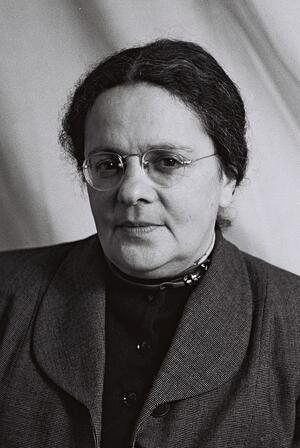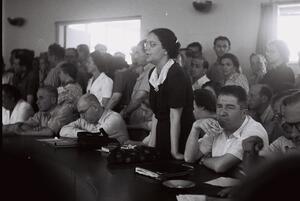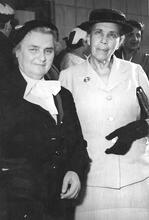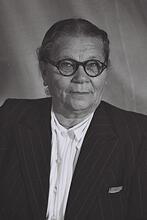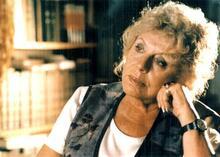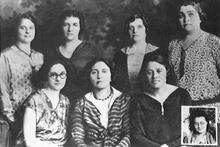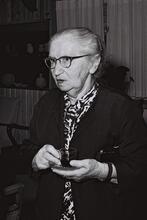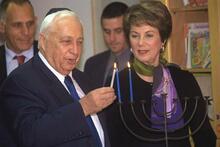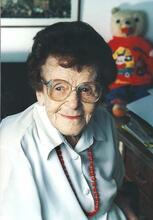Beba Idelson
Beba Idelson was an Israeli politician and dedicated Zionist activist. At an early age, she developed a strong Zionist identity. In 1917 she married Israel Idelson. The couple was exiled from the Soviet Union due to their Zionist political activity, and after living comfortably in Berlin from 1924 to 1926, they decided to relocate to Palestine. By forming relationships with leaders of the women workers movement such as Golda Meir, she was introduced to the unique problems facing women in the workforce. Thus began her relationship with the Women Workers’ Movement. She held various leadership positions and even served as a Knesset member. Her work was incredibly influential; she helped formulate shape the character of the State of Israel, especially through legislation relating to women.
Background and Early Life
Beba Trachtenberg was born on October 14, 1895, in Yekaterinoslav (Dnepropetrovsk), Ukraine, then part of the Russian empire. Her parental home was poor and unattractive and the family lived in hardship, primarily because her father, Yitzhak, had no regular means of income. The Trachtenbergs provide a good example of the changes undergone by East European Jewry at the time. Beba’s mother, Rivka Rizovski, was a pupil at the progymnasia, a kind of state junior high school. Her father, who was religiously observant, studied Lit. "teaching," "study," or "learning." A compilation of the commentary and discussions of the amora'im on the Mishnah. When not specified, "Talmud" refers to the Babylonian Talmud.Talmud but was also well-versed in the customs and practices of modern life. He sent his sons to heder and hired a private tutor for his daughters. One of the sons studied in the Russian gymnasium (high school), while another joined the social-revolutionary party and in consequence suffered from persecution. The daughters were all talented pupils and after completing high school went on to university to study subjects considered innovative at the time. The oldest daughter, who studied gynecology in Switzerland, later returned to Russia to establish a flourishing clinic.
When Beba Trachtenberg was eight years old, her mother died while giving birth to her thirteenth child. When Yitzhak Trachtenberg passed away four years later, the burden of caring for the family fell upon their grandmother and the older children, including Beba. She was thus early on exposed to the double burden of mothers: the need to combine working for a living with caring for the household and its members. Nevertheless, she continued with her studies. In 1912, when she was sixteen years old, she graduated from the Russian high school in her home town.
Developing a Zionist Identity
As a young woman Beba Trachtenberg was involved in Russian culture and in the revolutionary spirit sweeping it. Though she was not an avowed socialist, she was acquainted at first hand with the revolutionaries’ fate, since one of her brothers was compelled to wander from city to city in fear of his life. At this point in her life Trachtenberg took no especial part in Jewish life, although Yekaterinoslav, as a city where Jews were allowed to live, had a large and fairly active Jewish community. Among the major Zionist figures in the city were Menahem Ussishkin (1863–1941) and Jehiel Tschlenow (1863–1918), and other Zionist leaders frequently came on visits. The incident that brought Trachtenberg closer to Zionism occurred in 1913, with the blood libel known as the Beilis Trial. While Mendel Beilis (1874–1934) was awaiting trial for allegedly having murdered a Christian boy as part of the A seven-day festival to commemorate the Exodus from Egypt (eight days outside Israel) beginning on the 15th day of the Hebrew month of Nissan. Also called the "Festival of Mazzot"; the "Festival of Spring"; Pesah.Passover ritual, public opinion both in Russia and elsewhere grew violently antisemitic. This was an eye-opening incident for Trachtenberg and in the years that followed her Jewish and Zionist awareness steadily grew and deepened.
An additional stage in this process developed from a chance meeting during World War I. In 1915, at the height of hostilities, Trachtenberg continued to divide her time between university courses in economics and statistics, which she had begun the previous year, and meetings with people of her own age. She was deeply involved in Russian life and influenced by Russian culture. In consequence, her circle of acquaintances did not include many Jews or Zionists. But the encounter with Jewish refugees expelled from the western borders of Russia who arrived in Yekaterinoslav brought about a profound change. Trachtenberg, who had some contact with Jewish students in the city, volunteered to participate in relief activities which the community provided to the refugees. The participants in this work were close to the Ze’irei Zion (Zionist Youth) and their young, energetic leader was Israel Idelson, a student at the city’s Geological Institute. Trachtenberg grew ever more aware of her feelings for this leader—and for his ideas.
Refugee relief was not the sole activity of the time. Clashes between army deserters who had fled from the front and supporters of the Bolsheviks filled the towns and cities with violence. Armed robberies, murder, and rape led the young Jewish students and workers to set up self-defense groups. In 1916 Trachtenberg was a member of one such group, established by the Ze’irei Zion in Yekaterinoslav. The group was active throughout the Bolshevik Revolution, its members steadily becoming more and more identified with Zionist-revolutionary ideology. In 1917 members of the Ze’irei Zion group led by Israel Idelson joined the Zionist-Socialist Party (Z. S.).
The year 1917 marked a further stage both in Trachtenberg’s move towards Zionism and in her private life. At the beginning of the year, she married Israel Idelson (later Bar-Yehudah, 1895–1965). While he and his colleagues concentrated on political activity, she was busy establishing a household, which became a meeting place for members of the Ze’irei Zion, most of whom were unmarried. As a result, ideological comrades also became close friends, a kind of family, while the family was deeply involved in ideological and party activities. This web of personal connections was to accompany Trachtenberg in the years to come and to inform her life in The Land of IsraelErez Israel.
In 1919, when Israel Idelson’s political activity increased, the couple moved to Kharkov, where Beba Idelson continued her studies at the university. However, Israel’s political activity endangered the couple’s existence. Persecuted by the authorities, like other Zionist activists, the couple were arrested in 1923 and exiled to Siberia. That year their only child, Rivka, was born. As a result of Beba’s pleas and with the help of Maxim Gorky’s wife, the punishment and exile were replaced by expulsion to Palestine and in 1924 the Idelsons left the Soviet Union.
Now party orders began to rule the couple’s lives. Idelson was ordered by He-Halutz to go to Berlin. En route they stopped in Danzig, where the He-Halutz congress was due to take place. The numerous delegates who came from Palestine included Yehuda Almog (1896–1972), whom Idelson had already met during one of his visits to Russia. The years they spent in dynamic Berlin—1924 to 1926—were comparatively comfortable for the family. After her humble childhood, her life as a student working for her living and the hardships of revolutionary Russia, Beba Idelson was now exposed to the culture and convenience of a great, impressive European city.
Moving to Palestine
In April 1926 the Idelson family reached Palestine as part of the Fourth Lit. "ascent." A "calling up" to the Torah during its reading in the synagogue.Aliyah, which is generally considered to have been a non-pioneering aliyah. Beba Idelson was thus not one of the veteran pioneer elite who formulated the Zionist pioneering ethic—women such as Ada Maimon, Yael Gordon, and Rahel Katznelson, who launched activities among working women. By the time Beba Idelson arrived the Histadrut Women Workers Movement was already in existence and its various institutions firmly established.
During their first weeks in the country, the Idelsons lived with Beba’s sister Sima and her family in their modest hut. They received a warm welcome from party members and Israel was appointed secretary of the Workers’ Council in Petah Tikvah.
The year 1926 was one of economic crisis in the Jewish community in Palestine prior to the establishment of the State of Israel. "Old Yishuv" refers to the Jewish community prior to 1882; "New Yishuv" to that following 1882.Yishuv and Beba Idelson, like other women, had to take on seasonal agricultural work, picking citrus in the winter and grapes in summer and peeling almonds in the spring. Between seasons she pounded stones for gravel.
Despite the hard work, the Idelsons hosted many party leaders in their Petah Tikvah home, but Beba had to take Hebrew lessons in order to facilitate a true involvement in party activities and this she did at the neighboring women’s farm.
In 1927–1928 Beba Idelson worked as a statistician at the Jewish Agency in Jerusalem, where both the pay and the working conditions were vastly superior to those in agriculture. Here she also acquired a wider circle of acquaintances and strengthened her ties with labor leaders, but nothing in her work increased her interest in women-related issues.
In 1928, when Israel was appointed to the central comptrolling committee of the Histadrut’s Executive Committee (Va’ad ha-Po’el), the Idelsons moved to Tel Aviv. Despite this promotion, everyday life was no easier and Idelson had to continue to work for an income, for a while embroidering blouses. At the Ahdut ha-Avodah (Zionist Socialist Labor Party) clubhouse where both veterans and newcomers mingled, she first became acquainted with the issues of most concern to the workers in Palestine: relations with the British, settlement and “Hebrew labor,” workers’ wages, etc. But women-related matters received little attention.
Introduction to the Women Workers’ Movement
Experienced in providing support and assistance to movement members, Idelson became the club’s voluntary “housekeeper” and thus a well-known figure among its frequenters. She also formed a friendship with the leaders of the women workers such as Golda (Meyerson) Meir, who was for a short time the secretary-general of the Mo’ezet ha-Po’alot, Hannah Lamdan (1905–1995) of the Tel Aviv Women Workers’ Committee, Devorah Netzer (1897–1989), and others. She also volunteered to assist her colleagues whenever necessary: together with Genya Filnick she established the women’s employment bureau in Tel Aviv; she helped Hannah Lamdan conduct a census of women domestic help designed to facilitate organizing them in the Histadrut. The census made her aware of the sorry conditions of the female workforce and opened her eyes to the fact that working women had immense problems which were unique to them as women.
Idelson thus began her relationship with the Women Workers’ Movement in a local organization, the Tel Aviv Women’s Employment Bureau. In theory, this was subordinate to Mo’ezet ha-Po’alot, an institution of the elected women workers’ movement. In fact, the women’s movement was subordinate to the city’s (male) Workers’ Council and to the rule of the Ahdut ha-Avodah party. Idelson’s years of volunteering at the party’s club bore fruit. In the summer of 1931, when Rahel Katznelson and Ada Maimon were looking for a volunteer to replace them temporarily in the secretariat of Mo’ezet ha-Po’alot while they went to Switzerland as delegates to the Seventeenth Zionist Congress, Idelson, young and dedicated, was their natural choice. Thus she entered the narrow confines of the Mo’ezet ha-Po’alot’s room in the Va’ad ha-Po’el House in Tel Aviv. Here she began her long, exciting career as a leader of the country’s women.
Beba Idelson’s first task was to care for the needs of the domestic workers, who were living in desperate poverty. Lack of funds was a major obstacle to the development of the women’s movement. From the very first, Beba recognized how marginal the women’s establishment was and then came to realize that women needed a support organization, but one which was connected to the Histadrut if it was to be strong. Her success led to her becoming a permanent member of the secretariat once Katznelson and Maimon returned, and she retained this position until 1974.
In her new role, Beba Idelson urged the wives of members of the Histadrut and the Workers’ Movement to collaborate. She arranged the issue of membership cards which gave these wives the right to participate in party elections. She transformed Devar ha-Po’elet into a platform for the council, inter alia publishing details of the budget designed to educate women to public independence and expertise in related matters. She was one of the founders of the Organization of Working Women, which became a major component of the women workers’ movement. She also created close ties with the U.S. Pioneer Women, which she visited in 1936 and to which she was an official emissary in 1944. In addition, together with Ada Maimon and Rahel Katznelson-Shazar, Idelson was a board member of World WIZO, a position she held for sixteen years.
Idelson was active in the Council of Women’s Organizations established by Henrietta Szold in the mid-1930s and after the establishment of the State of Israel served as its first chairwoman, a post she held until 1953.
Later Career and Impact
A firm believer in the importance of women’s economic independence, Idelson strongly opposed the pressure applied to married women to resign from work during the years of hardship that plagued the Yishuv in the mid-1940s. With the support of the Histadrut, she forbade the dismissal of married women, arguing that women had a right to employment irrespective of their marital status. In her opinion, women’s equality was measured not only by rights but by obligations. Thus she favored the conscription of women into the British Army during World War II and supported legislation of a women’s National Service Law.
With the organizational development of the Histadrut in the 1930s, Beba Idelson became a board member of the newly created Mishan (a Histadrut mutual aid institution which supports orphans’ and old-age homes) in 1936 and a member of the Kupat Holim supervisory committee. In February 1960 she was elected chairwoman of the Histadrut’s ninth congress, a position of considerable power. In the mid-1960s she was a member of the Central Committee, the major body of the Histadrut’s Executive.
Idelson’s unstinting activity within the Women Workers’ Council and other Histadrut organizations led her to see herself as the representative of the “second generation” of Histadrut functionaries, but she was also active in the Zionist and Yishuv institutions in general. In 1935 she was a Mapai delegate to the Nineteenth Zionist Congress. She was also a member of the Elected Assembly and deputy to Izhak Ben-Zvi (1884–1963) in his capacity as chairman of the National Council. She was a member of Lit. "assembly." The 120-member parliament of the State of Israel.Knesset for sixteen years, beginning in 1949, and for a decade served as deputy speaker. However, her marriage to Israel Idelson did not survive the test of time. The couple separated and Israel moved to A voluntary collective community, mainly agricultural, in which there is no private wealth and which is responsible for all the needs of its members and their families.Kibbutz Yagur, while Beba remained in Tel Aviv with her long-time friend, Hayyim Halperin (1895–1973).
Beba Idelson developed her outlook on the Yishuv, its society, and women workers only gradually, in the course of her many years of activity. Clearly, this outlook was influenced by her experience as a hard-working girl, as a young woman close to Labor-Zionist circles on the eve of the Bolshevik revolution, and as one of those persecuted in the course of it. In addition, the lessons she learned as an observer of her husband’s political activities contributed to the formation of her own political autonomy.
Beba Idelson’s personality undoubtedly determined her path in life. She organized the Mo’ezet ha-Po’alot with great diligence, rejecting as a matter of principle the Bolshevik model of establishing a “women’s section” controlled by the party. She aimed at allying the Council with the general policies of the ruling party within the Histadrut. Totally loyal to the party line, she strengthened the institutionalization of the Mo’ezet ha-Po’alot, thus in fact tempering the independent and oppositional spirit which had occasionally swept the women workers’ movement—a spirit steadfastly embodied by Ada Maimon.
However, on some matters related to the labor movement in general she was totally uncompromising. She was most aggressive in her attitude towards the movement’s Revisionist rivals, objecting strongly to the 1934 agreement between Ben-Gurion and Jabotinsky, which was designed to moderate the bad relations between the factions. Throughout her life she remained loyal to Mapai, her political breeding ground, never joining any of the splinter groups that broke away from the party in the 1940s and 1950s, to all of which she strongly objected. On the other hand, she did not approve of the “chopping off of heads” which was so characteristic of the political culture of the time, and thus objected both to the behind-the-scenes scheming which led to the final resignation of Pinhas Lavon (1904–1976) and to the ousting of Moshe Sharett (1894–1965) from his post as foreign minister.
With the establishment of the state the area of Beba Idelson’s activities switched from local to national. She helped shape the character of the new state, especially through legislation relating to women. While these laws were not flawless, they laid the foundations for the public status of women in Israel. Faithful to the concept of equality which had guided her throughout her life, she defined women’s struggle as one for fulfilling civic obligations. Thus she demanded that the law be entitled Equality of Human Rights, not merely Women’s Rights. Among the laws which she helped formulate was that relating to marital age (1951); the law concerning women’s work (1953); the National Insurance Law (1953), which includes clauses relating to the insurance of mothers and payment of pensions to widows; the Law on Marriage and Divorce (1953), designed to recognize civil marriage (which was not passed); the Inheritance Law (1958); the Criminal Law Amendment (1959); and the Equality Law (1962). To the end of her life Beba Idelson made every effort to establish family courts in which women would be able to present their case equally with men, but in this she was unsuccessful.
The mid-1960s were a turning point in Idelson’s public activity as she distanced herself from the centers of political life. In 1965, when she was named “Mother of the Year,” she decided to resign from the Knesset. The process of retirement continued until 1974. At the tenth Congress of Women Workers she announced that she would no longer be a candidate for election to the secretariat, but she retained her position as president of the World Movement of Pioneer Women.
Idelson’s death in 1975 marked the end of an age of the veteran founders of the women workers’ movement. Although she was not a literary person and left no written formulation of her ideology, Mo’ezet ha-Po’alot—which she developed in her own image and according to her own desires—was the epitome of her life and the words with which she summarized the role of the determined individual in society—“The movement is the being!”—may serve as her epitaph.
Or, Shulamit. On the Tenth Anniversary of Beba Idelson’s Passing. Tel Aviv: 1992.
Bernstein, Deborah. The Struggle for Equality: Urban Women Workers in Prestate Israeli Society. Tel Aviv: 1987.
The Socialist Zionists. Tel Aviv: 1973.
Maimon (Fishman), Ada. Fifty Years of the Women Workers’ Movement, 1904–1954. Tel Aviv: 1956.
Na’amat. Lexicon of Women in Israel. Tel Aviv: 1991, 7.
Raday, Frances, Carmel Shalev, and Michal Liban-Kooby, eds. Women’s Status in Society and Law. Tel Aviv: 1995.
Shavit, Ya’akov, Ya’akov Goldstein, and Hayyim Be’er, eds. Lexicon of Israeli Personalities. Tel Aviv: 1983, 37.
Stern, Batsheva Margalit. “‘The Queen Has No Home, the King No Crown’: The Status of Jewish Women in the Work Force during the Mandatory Period.” In Economy and Society during the Mandate, 1918–1948: Studies in Israel’s National Rebirth. Ben-Gurion University of the Negev, 2003, 107–152.
Stern, Bat-Sheva Margalit. Geʼulah Bi-khevalim: Tenuʻat Ha-poʻalot Ha-Erets Yiśreʼelit 1920-1939 Jerusalem: Yad Yitsḥaḳ Ben-Zvi and Schechter Institute of Judaic Studies, 2006. [Hebrew]

